




introduced by
ANTHONY MOULD athene
pallas
athene
pallas
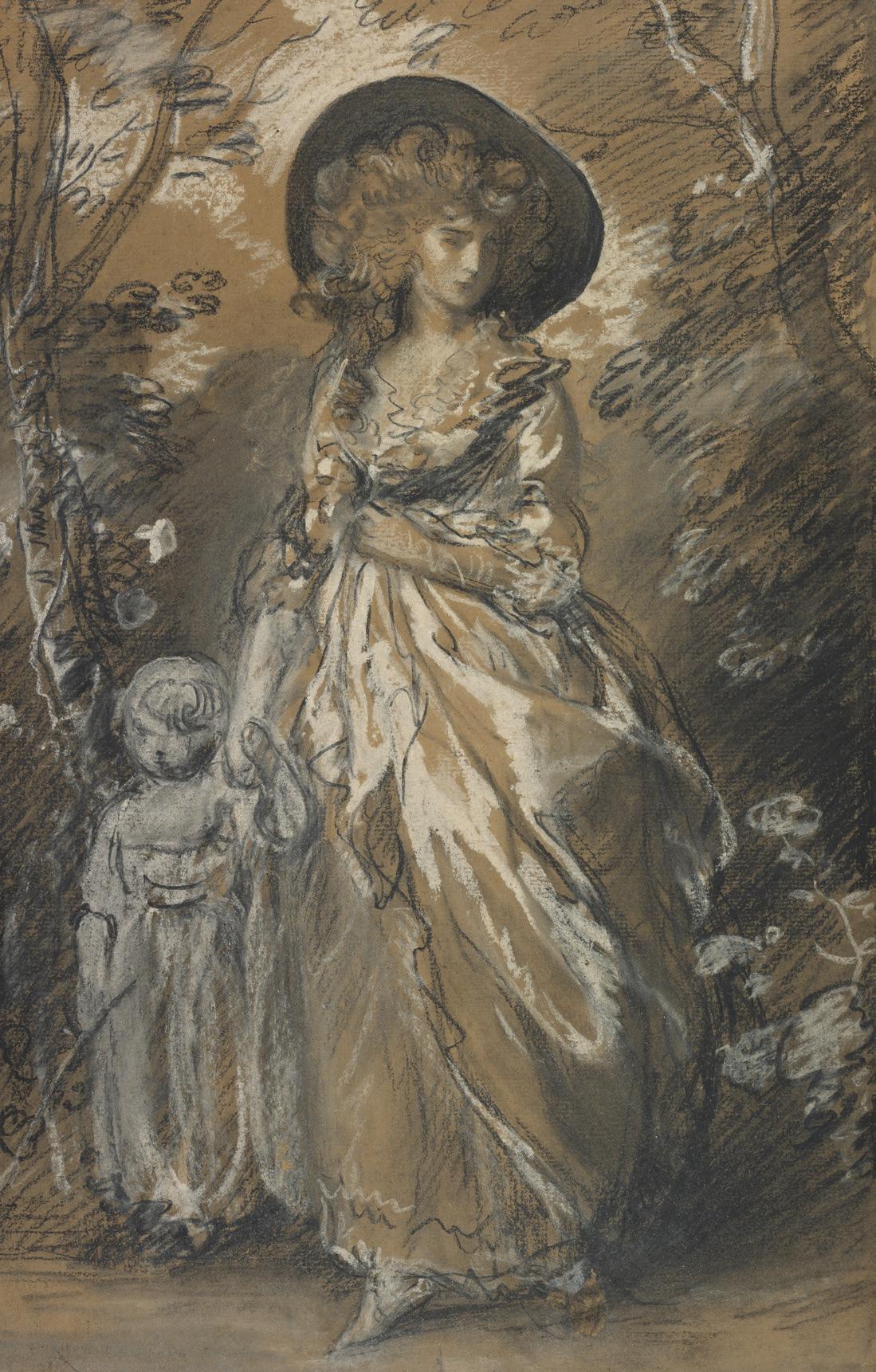
CONTENTS Introduction by ANTHONY MOULD
p. 7
A Sketch of the Life and Paintings of Thomas Gainsborough
PHILIP THICKNESSE
p. 29
Character of Gainsborough WILLIAM JACKSON
p. 85
Character of Gainsborough: his excellencies and defects
SIR JOSHUA REYNOLDS
p. 109
List of illustrations
p. 142
Opposite: Woman walking in a garden with a child, c. 1785
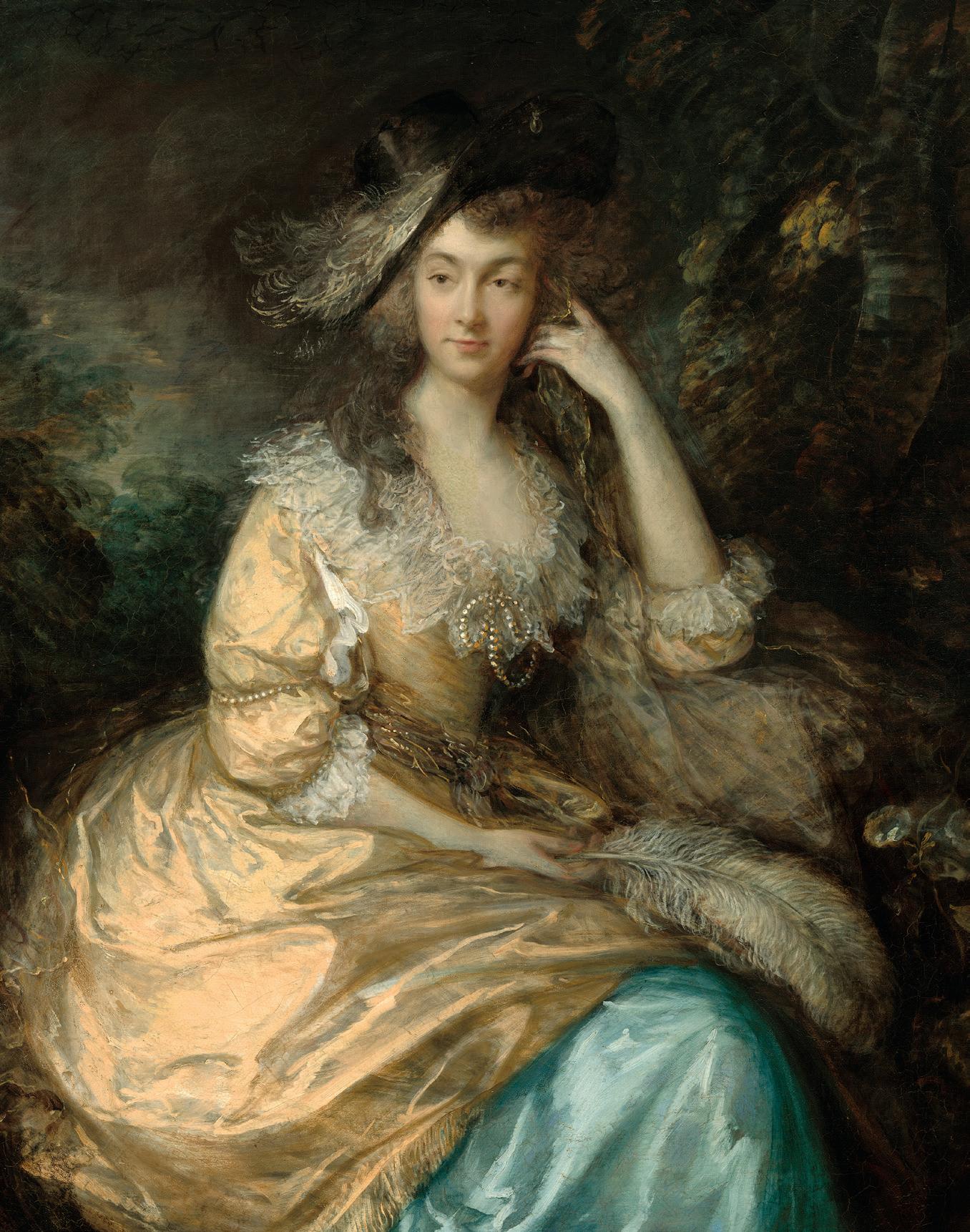
The sixty-one-year-old Thomas Gainsborough died with little fanfare in London in the summer of 188. Journalistic response was muted, and unlike Sir Joshua Reynolds, whose funeral would witness several ducal pall-bearers, his own was by choice more modest. Within weeks however, the ever-opportunistic Philip Thicknesse (119192) had produced his pop-eyed Sketch of the Life and Paintings of Thomas Gainsborough. Ten years later another, far more considered, personal memoir appeared, by the Exeter-based musician William Jackson (130-1803). Both of these attested to Gainsborough’s quicksilver charm and wit, and linked his art with his musicianship, an insight that still illuminates his work. Gainsborough’s fellow artists also wrote about his technique and his achievement, none more carefully than his great rival Reynolds himself, who devoted his fourteenth Discourse in 190 to Gainsborough. It was not then until after 1850 that appreciation picked up again, in tandem with a landmark exhibition of the Blue Boy (ill. p. 19) and
Opposite: Frances Susanna, Lady de Dunstanville, c. 1786
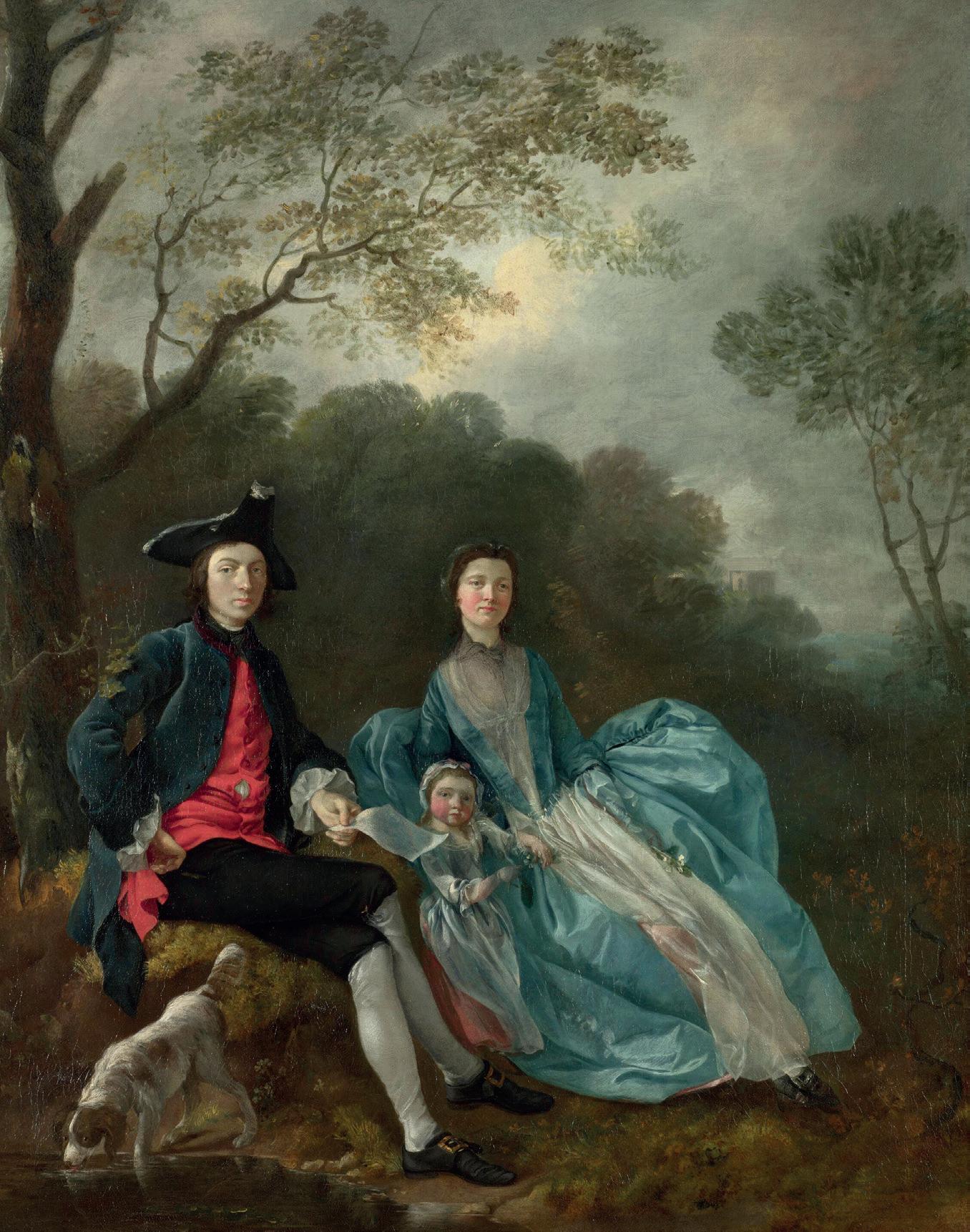
a stratospheric rise in prices. Consequently these early accounts have a particular value from being so close to events and giving us a direct impression of Gainsborough the man – and hence, very largely, of the painter too. It could be argued there are few painters whose temperament and outside interests are so evident in their art, far more than theory or ideology.
‘Nature was his teacher,’ declared his obituary in the Morning Herald, and he was a youthful prodigy, painting several notable landscapes (current whereabouts unfortunately unknown) between the ages of eight and ten in Sudbury, Suffolk, the town where he had been born in 12. He may have been helped on his way by his mother, who was a competent flower painter, and must have provided early encouragement in both the graphic and plastic arts. (His father was a cloth merchant.) Supported by a wealthy paternal uncle, the young Gainsborough subsequently trained in a Hogarthian idiom at the newly formed St Martin’s Lane Academy in London.
In July 146 he married Margaret Burr, the illegitimate daughter of the third duke of Beaufort, who had an annuity settlement of £200. This was a defining moment in his career: it enabled him to set up his own painting
Opposite: Self-portrait with his wife and daughter, c. 1748
Overleaf: Mr. and Mrs. Andrews, c. 1750

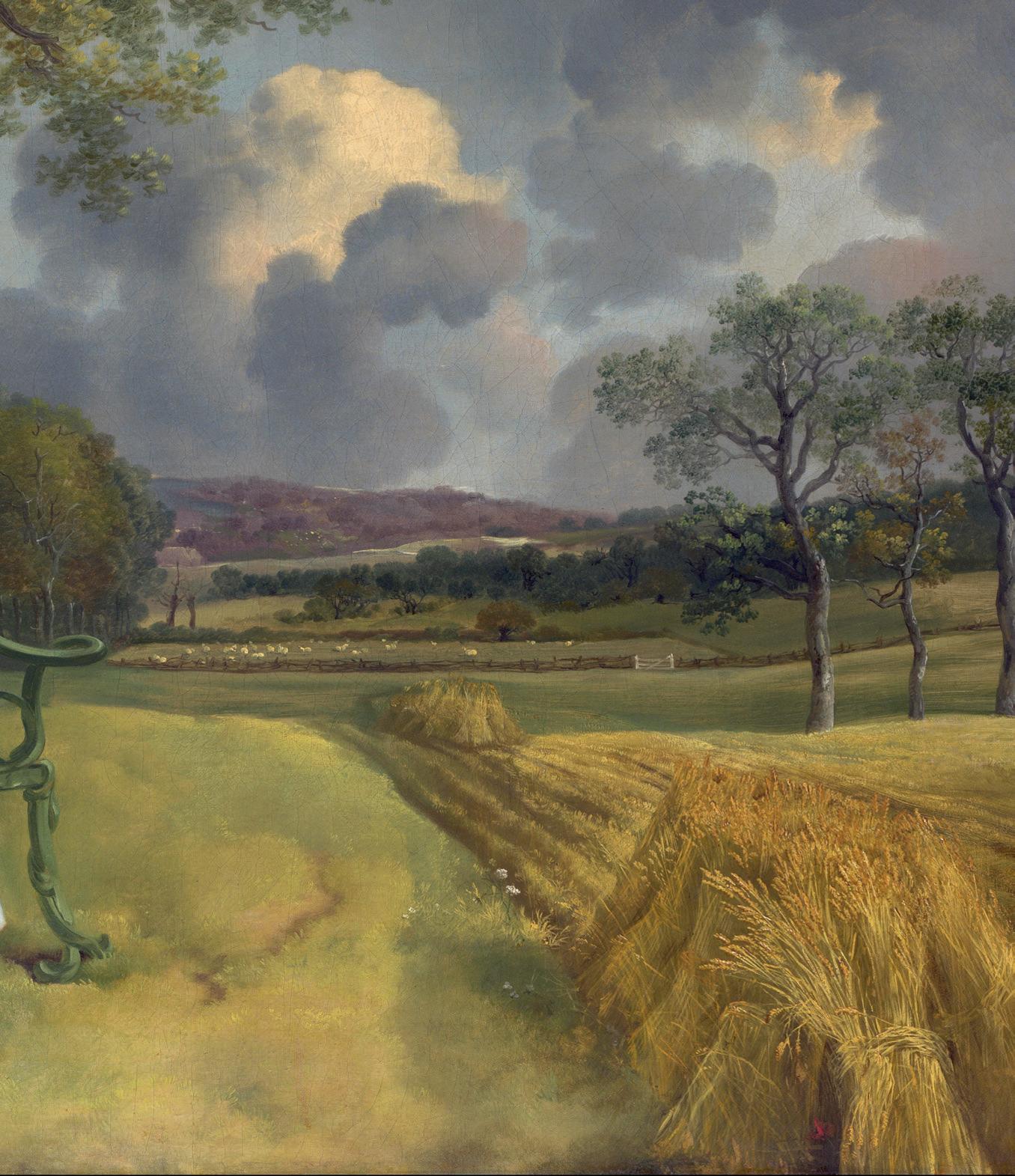
practice in Friar Street, Ipswich, in 152. East Anglia was well-to-do, and picking up on the prosperity and confidence of the expanding empire. Art collecting, town and country house building, and middle class patronage of all varieties, were beginning to create opportunities for any aspiring portrait or landscape painter. Gainsborough was in the right time and place. It was very shortly after his arrival in Ipswich that he must have first met – or been ‘discovered’ by – Philip Thicknesse. Thicknesse, one of the most cantankerous of English eccentrics, then had the prestigious post of governor of Landguard Fort in nearby Felixstowe. He did indeed commission, as he says, a large topographical view that was engraved by Thomas Major in 153 and for which he had paid fifteen guineas (p. 41). But there were already connections with other patrons, such as the wealthy, perceptive and influential Price family of Foxley in Herefordshire. The Prices, close kin to the Beaufort family and surely aware of Gainsborough’s skills by the time of his marriage in 146, were also commissioning him in early Bath days and may indeed have had a sounder claim to such a ‘discovery’.
Whatever the truth, Thicknesse was to develop an obsessive concern with having ‘discovered’ the young painter that almost extended to a fanatical sense of ownership of the whole family. He may have influenced
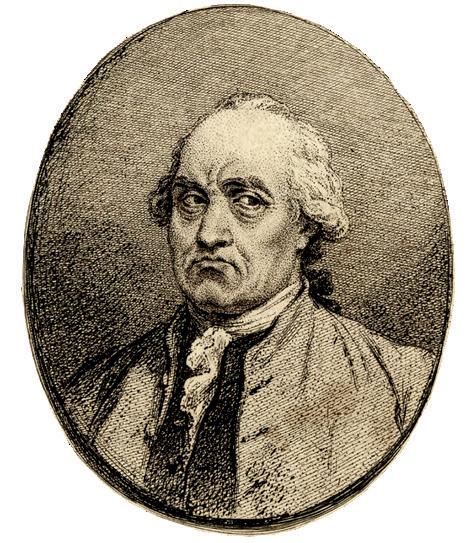
Gainsborough’s move to Bath; he certainly kept up with the painter there, and his account gives a colourful, if surely not strictly accurate picture of Gainsborough’s life in the city. They were both part of the city’s musical circles, with Thicknesse latterly marrying Ann Ford, a performing musician whom Gainsborough painted in 158 (p. 46). But Thicknesse was unfortunately something of a ‘nearly’ man, envious of the talents of others. With an eye to the main chance, his often accusatory comments ultimately speak more of his own misplaced vanities than of Gainsborough’s implied lack of humility. Æsthetically, Thicknesse’s remarks on the young Gainsborough’s understanding of colour and his trumpeted expertise of the eager but limited young apprentice Dupont border on the jejune and betray a certain naïvety.
That he also brought about the Gainsborough family’s next move, their permanent departure from Bath to London in 14, may simply be another fanciful claim. Of the uncompleted portrait of Thicknesse that is the key to this narrative, nothing survives.
Thicknesse emphasizes Gainsborough’s musical enthusiasms, which sometimes seem stronger than his vocation as a painter. The other early biographer, William Jackson, also straddled both worlds. An organist at Exeter Cathedral from 1, Jackson was also a competent artist, working occasionally, if somewhat nervously, in Gainsborough’s style. His essay, part of an Ovidian exercise called the Four Ages, attempts a more thoughtful analysis of Gainsborough the artist, which he takes up again in a subsequent chapter on the ‘Character of Joshua Reynolds’ whom he also knew well.
In the Four Ages Jackson sets up Gainsborough as the spontaneous empirical observer in contrast to Reynolds, the academically superior and somewhat pedagogic rationalist. Reynolds had already observed in the 190 Discourse that his rival’s ascent had come about without the assistance of ‘an academical education’ but Jackson’s more complete seer/thinker contrast is surely overstated. If one turns to Gainsborough’s letters – and Jackson himself observes ‘For a letter to an intimate friend he had few equals, and no superior’ and even compares them to
William Jackson, drawing by John Downman, 1781

the electrifying epistolary style of Lawrence Sterne – one can see a near-forensic mind at play. Like the drawings, Gainsborough’s letters were often executed at speed, but with subtle changes of tense and tone that suggest that if he had so wished, he could have been a public match for his more vocal and voluble arch-rival Sir Joshua.
Nor was Gainsborough in any way romantic or unworldly. It seems that he was a natural teacher, and he was certainly a successful businessman. His drive to carve out a well-defined commercial niche is seen in his systematic and uncanny knack of creating a portrait ‘likeness’ – as if a sitter were depicted from several angles simultaneously – which he had already developed in the early Ipswich
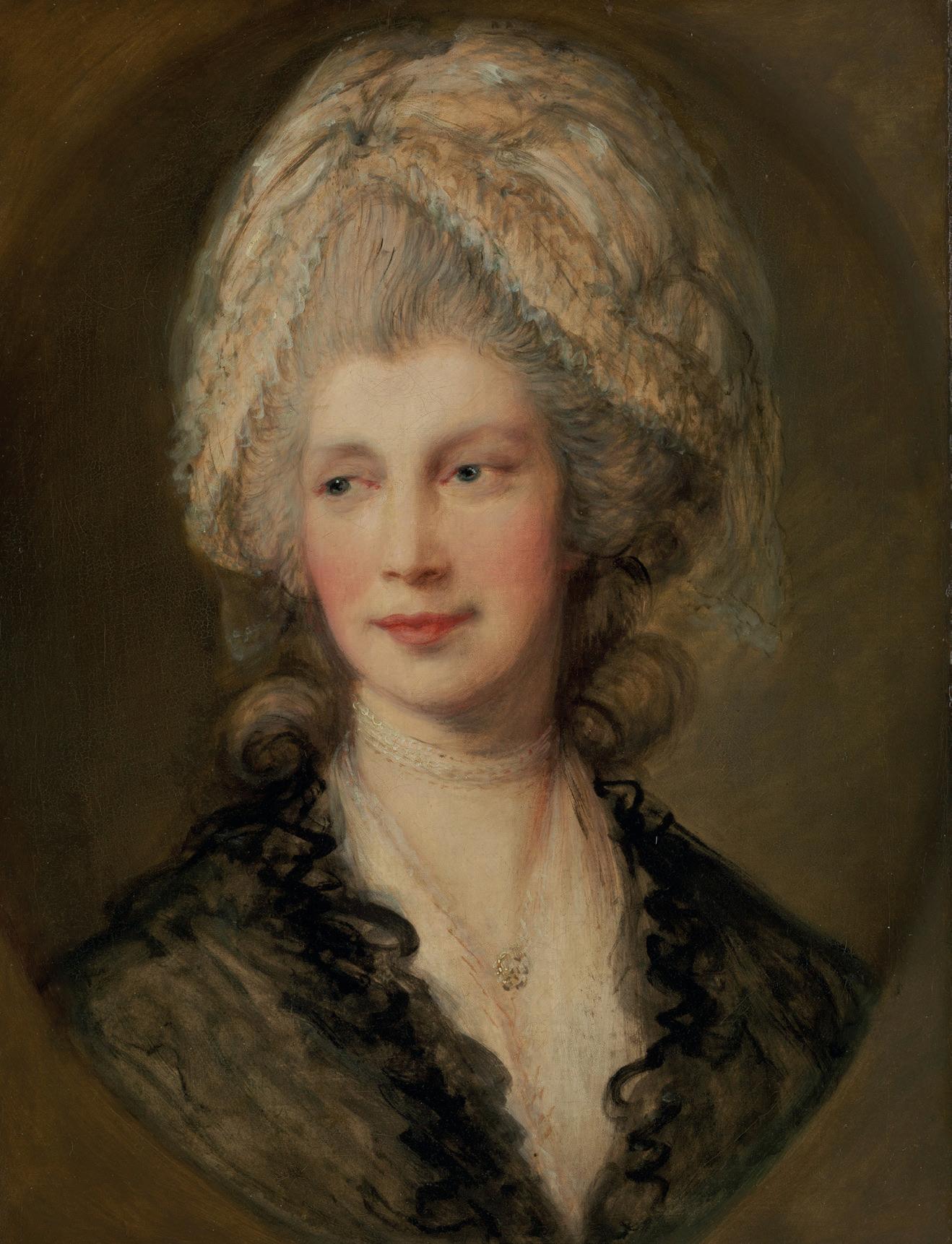
days, when he was setting himself up and had a burgeoning family to support. Martin Postle has described how Gainsborough combined a sharp and intuitive business sense with an ability to create and sustain an elevated circle of clients though a blend of charm and social flexibility. Prices for his paintings continued to rise with an increased demand, and if one client proved impatient, there was always another earl, squire, or prosperous landowner at the studio door. While excoriating some of his clients in private correspondence, his practice thus grew steadily in both scale and grandeur, and by 183 he was the King’s painter in all but name with a lively, easygoing, sometimes pedagogic relationship with the royal family. This represents the summit of his material achievements, but there was never an intellectual let-up. Jackson’s quip that at times painting was Gainsborough’s pleasure and that music was his profession should not invite the conclusion that at any point he was an amateur painter-practitioner. All the indications of more recent research and Gainsborough’s own letters support the view that his own understanding of ‘genius’ was something brought about by an earnest imitation rather than arrived at by unanticipated inspiration. Jackson relates elsewhere that on his deathbed Gainsborough
Opposite: Queen Charlotte, 1782
bemoaned the fact that after fifty years of practice ‘I am only just beginning’ and it was reported by Farington, that according to William Pearce who was there present, that he also stated that ‘Vandyke (sic) was right’. What this remark precisely meant eludes us, but from the earliest stage copying and imitating others, the variegating and modulating of versions inspired by old master painters from Ruisdael to Murillo is testament to an attempt at universality in his pictorial psyche. This mirroring of Van Dyck, who was himself a veteran copyist, and which was achieved according to Reynolds, to ‘perfection’, is reflected in his own systematic repetitions of his own paintings, either for commercial purposes or as an exercise best understood as a kind of modulation and counterpoint, almost musical in form. How these variant repetitions and versions were ever exhibited is not yet clear, but there are numerous examples of citations of both landscapes and portraits, often for reasons as yet unexplained. They are never ‘modulated’ in exactly the same way on closest physical examination and what this can mean we do not yet know. Gainsborough, though restlessly active (he was undoubtedly the most prolific draughtsmen of his time) was also capable of intense observation: Jackson playfully observed that he got as
Opposite: The Blue Boy (probably Jonathan Buttall), c. 1770
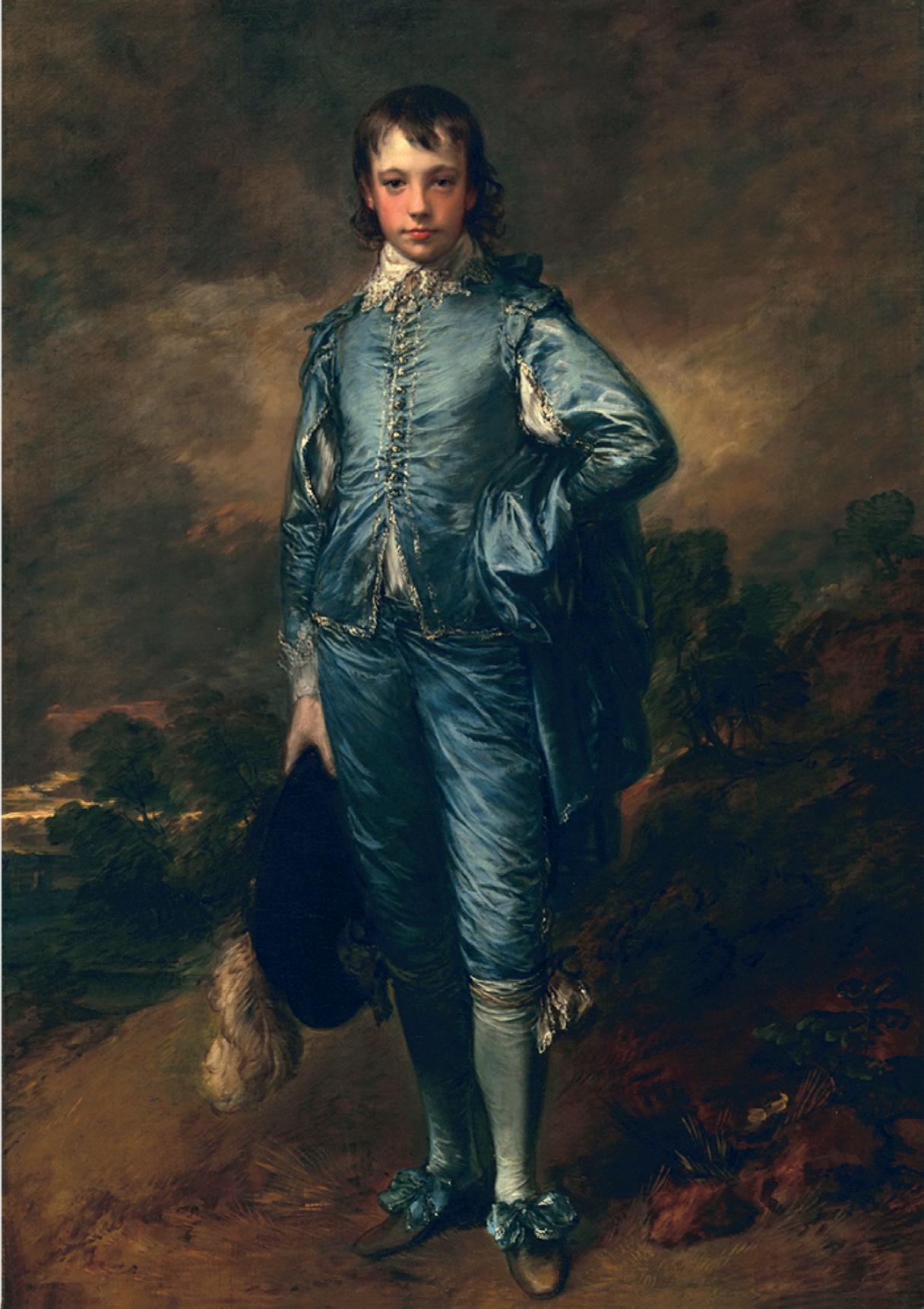
much pleasure from looking at a violin as from playing it, but another musician, Hamilton, noticed the trancelike state that apparently overcame him when gazing ‘riveted’ at a musical instrument for fully half an hour, overcome by the sheer beauty of its manufacture. For Gainsborough ‘copying’ and ‘looking’ were perhaps parallel disciplines.
Ultimately it is the refined classicism of the seasoned and wide-ranging copyist that is perhaps the key to the man. One might compare Johann Sebastian Bach, who frequently reused works from other composers, and never hesitated to reconfigure his own work. For both of them, one might say, the process was just one more continuing aid to a greater personal refinement. Gainsborough was in fact a close friend of Bach’s youngest son and pupil, Johann Christian, music master to Queen Charlotte, and painted him twice (see p. 90). Through J. C. Bach he also knew the great viola da gamba player, Carl Friedrich Abel, another pupil of Johann Sebastian, and could even have met the young Mozart on his visit to London in 164. Mozart later wrote variations on a minuet by Johann Christian Fischer, the oboist who married Gainsborough’s daughter Mary in 180. Gainsborough was a constituent part of a tight and exalted musical circle and even wrote music – now missing – himself. Like Mozart, who appears to have performed and
reused works by both Bach and Abel while in London, Gainsborough was therefore not simply a ‘natural’ painter but on the contrary understood and explored his position within an existing tradition. Thus, although Jackson states that Gainsborough had ‘no relish for historical painting’, it must have been an irony for both him and for Reynolds, who had spent an entire career promoting the importance of history painting, that arguably Gainsborough’s most successfully elegant oil composition of the 180s was his ‘historical’ painting of Diana and Actæon, now in the Royal Collection in London, astutely acquired by the Prince Regent from the young Gainsborough Dupont in 19 (ill. overleaf).
A response to brief passages of natural description occurring within Ovid’s Metamorphoses, this composition approaches a constructional perfection that breaks new technical ground. As a veteran painter, he was surely now aware of this, and it is no surprise that the painting remained with him in his studio. It is a work that defies strict categorization in a hierarchically demanding and institutionally conventional artistic environment. Larger than a Constable six-footer, it is a fusion of the informal imagery of Watteau and Fragonard and the more classicised formality of ‘High Art’. An essay in ‘studied carelessness’ it is also a ‘history’ painting to compare with a late Titian, and an unconscious prefiguration of Cezanne’s
Diana and Actæon, c. 1785-88
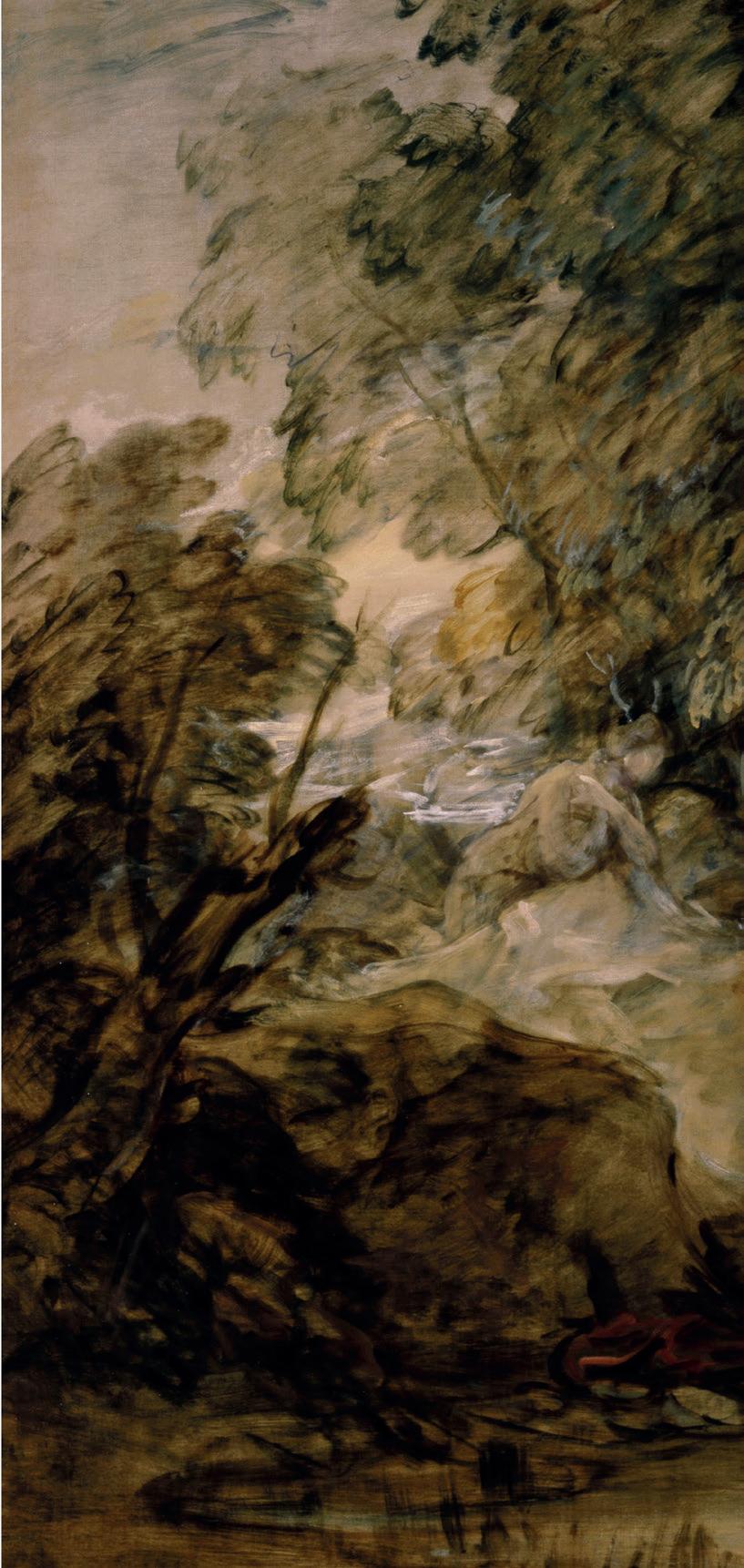
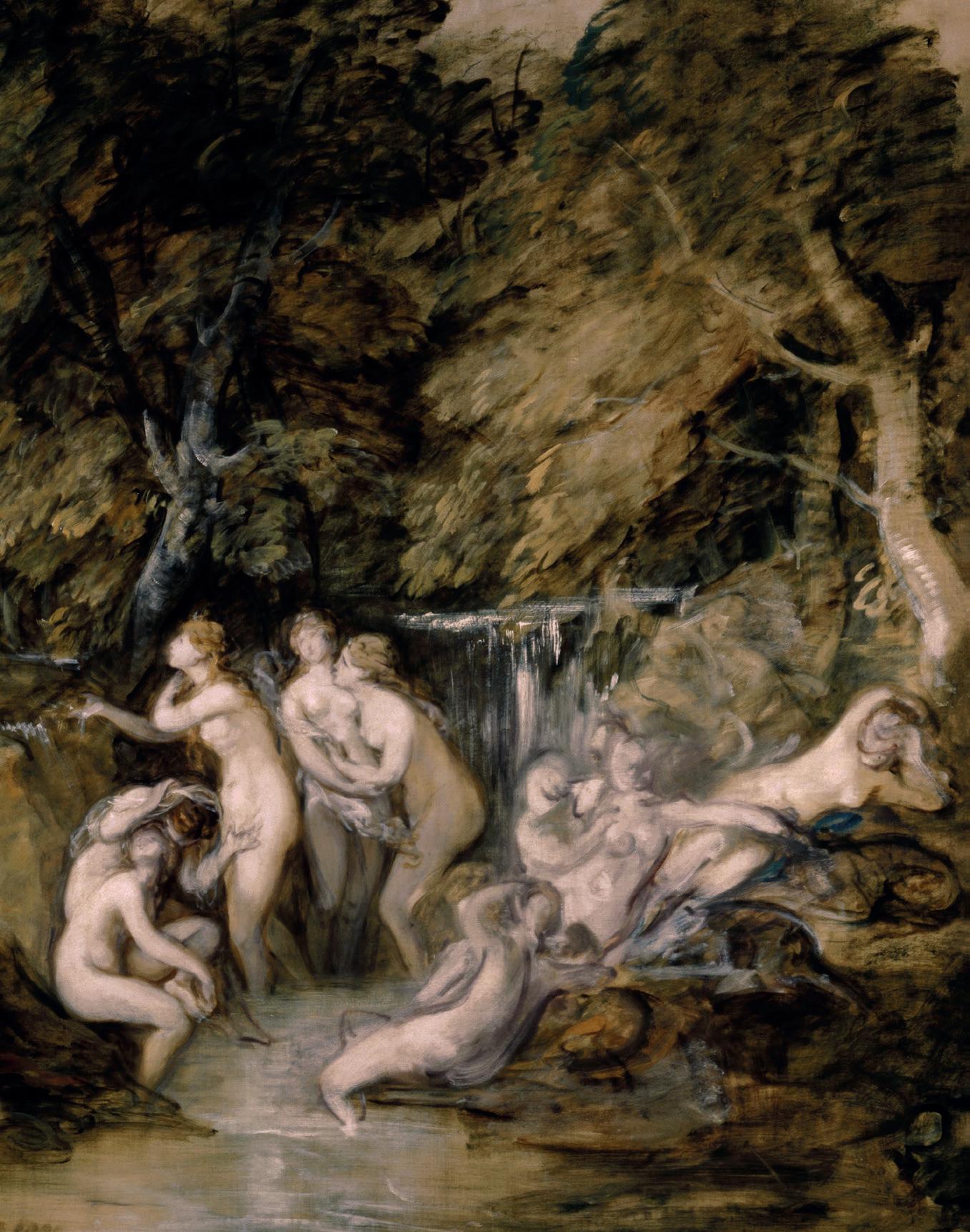
famous series of Bathers. Like his own fine Musidora in the Tate, which draws upon a characterization within the widely read Thomson’s Seasons, it subtly acknowledges academic norms and conventional literary and classical sources, despite Jackson’s assertions. It represents a new and thrilling way forward. It is also the painting by which its creator should now be best judged. If for Gainsborough this is the moment that represented a ‘beginning’, it had already had its subliminal roots in his youthful Cornard Wood (National Gallery), where water is pictorially manipulated, or in his little nocturnal compositions from broccoli, coal, clay, moss and broken-looking glass that were almost sculptural in format, and in the originality of the multiple designs of sheep and water that he could always draw, quite literally until the cows came home. Its light tone, fluidity of pigment, and control of composition that holds our attention today, ‘unfinished’ as it perhaps is, for perhaps it is not? According to one of Reynolds’ paraphrased quotations of his rival in the Discourses, ‘his regret at losing his life was the regret of leaving his art’. Did Gainsborough feel himself on the edge of something momentous here, a sense surely exaggerated by impending mortality but nonetheless less probably true? Diana and Actæon asks the more modern question of how or
Opposite: Musidora, c. 1780-88
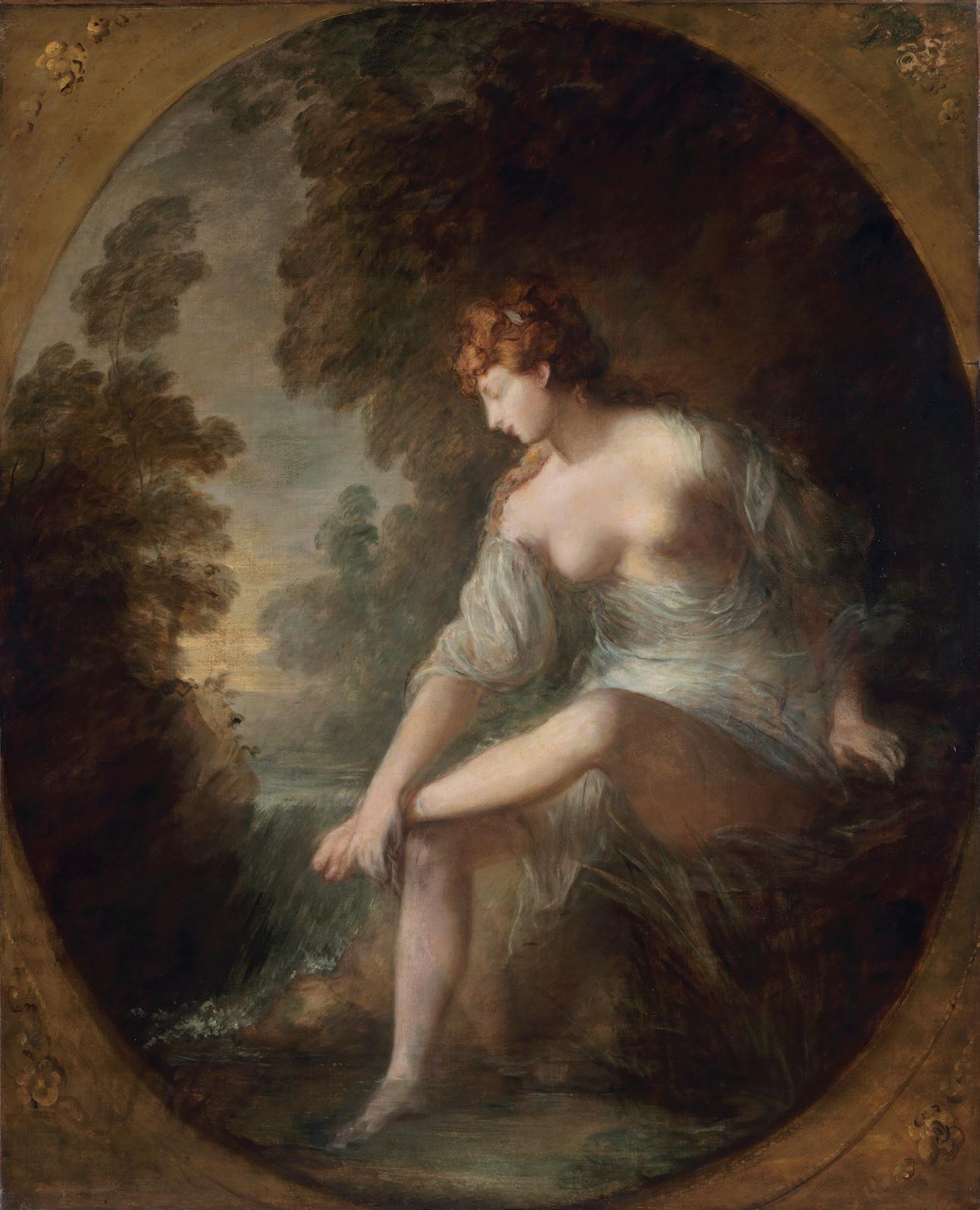

when any ‘finished picture’ really is exactly that. It was the Slade Professor Euan Uglow who pithily commented that no picture is ever ‘finished’ (nor, by implication, will it ever be).
In fact this quality is part of Gainsborough’s entire character as a painter. Almost all commentators remark upon the speed of execution which facilitated his methods and was indeed integral to it, with the outcome being uninhibited by this rare combination of immediacy and of dexterity. One of the best known examples of this is perhaps the half-length oil on canvas portrait of the young musician Samuel Linley at the age of eighteen, now in the Dulwich College collection and executed, bewilderingly, in well under an hour in 18. We might even wonder if it was perhaps Gainsborough’s ‘studied carelessness’ that had ultimately infuriated Thicknesse, not just the cavalier failure to complete his full-length portrait once commenced. This was behavioural sprezzatura, Castiglione’s word for the insouciance that marked out the gentleman-courtier. Jackson writes at one point about the airiness of both Gainsborough’s letters and his conversation, compared it to that of a swallow. This observation ought not be allowed disguise Gainsborough’s originality, his attempts at universality and lifelong quest for the mastery of perfect Opposite: Samuel Linley, 1778
pitch. ‘Damn him how various he is,’ Gainsborough apparently once remarked enviously of Reynolds, when walking through the Royal Academy.
Thomas Gainsborough was manifestly a warm and affectionate character with a strong sense of his own worth and an ability to make friends quickly, but without always the time to sustain them as he might have wished. Ambition could get in the way. He was not quarrelsome, but friendships required servicing. Thicknesse, though himself capable of quarrelling with anyone, appears genuinely grieved by their estrangement. The friendship with Jackson cooled owing, it seems, to Gainsborough’s drinking. With Reynolds there had never been a closeness, and nothing came of the 182 agreement to paint each other’s portraits in almost gladiatorial fashion. Yet when he was close to death Gainsborough asked Reynolds to come to see him, and the mutual declaration of respect is movingly if discreetly conveyed by Reynolds in the Discourse. ‘Without entering into a detail of what passed at this last interview, the impression of it upon my mind was, that his regret at losing life was principally the regret of leaving his art’. Not just, however, his own: ‘We are going to heaven,’ Jackson famously reported him saying, as his last words, ‘and Van Dyke will be of the company’.